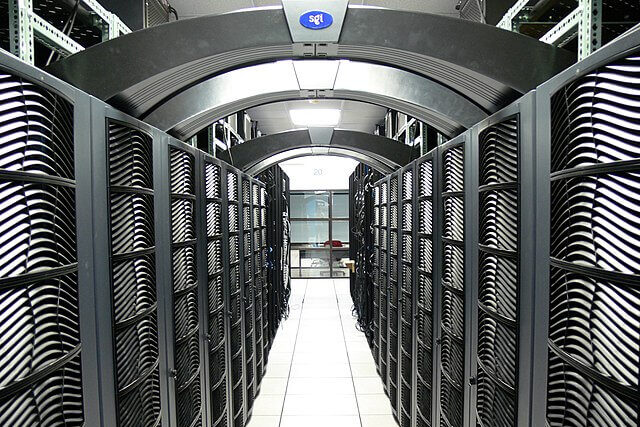
Data centres’ soaring electricity demands have been accused of slowing the United States’ transition to clean energy and forcing fossil fuel plants to remain in operation. Their substantial water consumption has also raised concern. Now, public health advocates fear another environmental issue may be linked to them – pollution from PFAS “forever chemicals”.
Major technology firms such as Google, Microsoft and Amazon rely on data centres to house servers and networking equipment that process global digital traffic. The rapid expansion of artificial intelligence is further driving demand for such facilities.
Campaigners are particularly worried about the use of PFAS gases, or f-gases, within data centres. These can be potent greenhouse gases, suggesting that the facilities’ climate impact may be greater than previously thought. Some f-gases also transform into a dangerous compound that is accumulating rapidly across the planet.
No testing has yet been carried out for PFAS contamination in air or water, and companies are not required to disclose the quantity of chemicals they use or release. However, several environmental groups are now pushing for state-level legislation to introduce mandatory reporting.
Concerns grew in mid-September when the Environmental Protection Agency (EPA) announced it would fast-track its review of new PFAS and other chemicals used by data centres. The industry maintains that the PFAS it uses causes minimal pollution, but campaigners strongly disagree.
“We know there are Pfas in these centers and all of that has to go somewhere,” said Jonathan Kalmuss-Katz, an attorney with the Earthjustice non-profit, which is monitoring Pfas use in datacenters. “This issue has been dangerously understudied as we have been building out datacenters, and there’s not adequate information on what the long term impacts will be.”
PFAS refers to a group of around 16,000 chemicals commonly used to make products resistant to water, stains and grease. These compounds have been linked to cancer, birth defects, weakened immune systems, high cholesterol, kidney disease and a range of other serious health conditions. They are known as “forever chemicals” because they do not naturally break down in the environment.
Environmental advocates say data centres contribute to PFAS pollution both directly and indirectly. The chemicals are used in cooling systems, which almost certainly leads to on-site contamination. Equipment containing PFAS must also be disposed of, yet these substances cannot be completely destroyed. In addition, large quantities of PFAS are used in the manufacture of semiconductors housed within data centres, increasing pollution around the associated production plants.
These revelations come as the US seeks to strengthen its position as a global leader in AI, with little political appetite for curbing data centre pollution.
“The US and China are racing to see who can destroy the environment most quickly,” said Lenny Siegel, a member of Chips Communities United, a group working with industry and administration officials to try to implement environmental safeguards. “If we had a sensible approach to these things then someone would have to present some answers before they develop and use these systems.”
Two main cooling systems are used to prevent semiconductors and other electronic equipment in data centres from overheating. Water-based cooling systems consume vast amounts of water, often treated with chemicals such as nitrates, disinfectants and azoles, which may later be discharged into the environment.
Many facilities are now switching to “two-phase” cooling systems that use f-gas refrigerants circulated through copper tubing. Although f-gas is not intended to be released during operation, leaks can occur, and the gases must be safely disposed of at the end of their life cycle.
The data centre industry argues that any f-gas released poses little risk because, once airborne, turns into a compound called Tfa. TFA is classed as a PFAS in most countries, but not in the US. Recent research, however, suggests it is more toxic than previously believed and may affect reproductive systems in ways similar to other PFAS compounds.
Scientists have expressed growing alarm at the rising levels of TFA found in air, water, human blood and elsewhere in the environment. Meanwhile, some f-gases are extremely powerful greenhouse gases that can persist in the atmosphere for thousands of years. They are also highly profitable: around 60% of all PFAS produced between 2019 and 2022 were f-gases.
Other PFAS are used to coat cables, piping and electronic components within data centres. These volatile substances can evaporate directly into the air.
When such equipment or waste is removed from data centres, it is often sent to landfill — where it can leach into local waterways — or incinerated. Yet incineration does not fully destroy PFAS; it breaks them into smaller fragments that remain PFAS, or into by-products with unknown health effects.
“Data centres are a huge generator of electronic waste, with frequent upgrades to new equipment,” said Mike Belliveau, founder of the Bend the Curve non-profit, which campaigns for stronger toxic chemical legislation.
“The processing and disposal of electronic waste is a major source of global harm,” he added.
F-gas manufacturer Chemours has cited the boom in AI and data centres as justification for expanding production at its plants in Parkersburg, West Virginia, and Fayetteville, North Carolina.
Both sites have faced accusations of contaminating local water, soil and air, and of poisoning drinking water supplies. Residents claim their health has suffered as a result. Chemours’s expansion plans have been met with strong opposition amid fears of worsening pollution.
A new coalition of environmental groups in Minnesota is working with state legislators to draft a law requiring companies to disclose their use of PFAS and other chemicals in cooling systems.
Lawmakers have questioned technology firms about which substances are used in their data centres and how they are disposed of, but “the answers are not satisfactory,” said Avonna Starck, Minnesota state director for Clean Water Action, which is leading the initiative.
“There’s so much you just don’t know and we’re at the whim of these big corporations and what they’re willing to tell us,” Starck said. “We think the community has a right to know these things.”
——————————————————————————
At Natural World Fund, we are passionate about restoring habitats in the UK to halt the decline in our wildlife.

